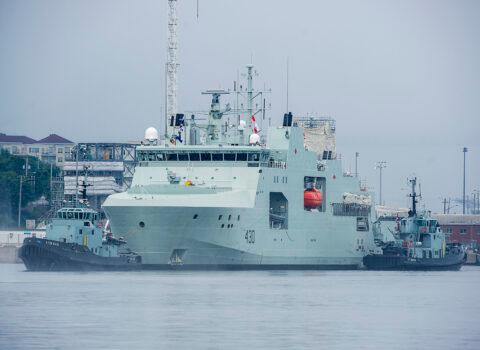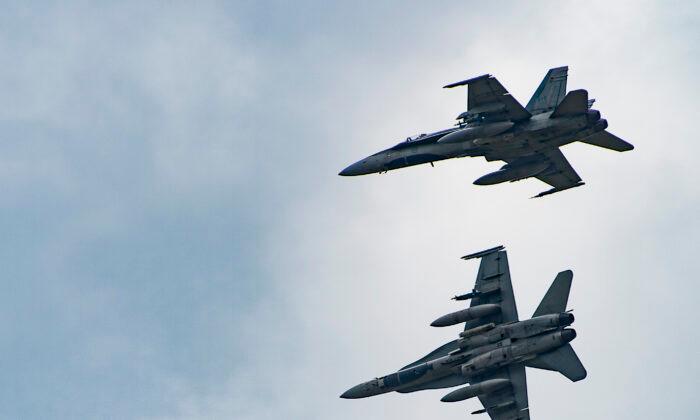Canada’s military passed two key milestones to end July. It received three bids to build the next fleet of fighter jets and saw the delivery of its first new Arctic warship since the 1950s.
But after the accolades subside, what remains sobering is the reality and gravity of Canada’s ponderous defence procurement—delivery of the first new jet is not expected until 2025—and doubts about military funding amid growing threats from China and Russia.
Both milestones come after lengthy delays and aren’t a sign of any procurement process improvements, defence expert and Macdonald-Laurier Institute senior fellow Richard Shimooka told The Epoch Times.
“It’s the rate of progress that’s probably most problematic,” he said, adding that things eventually get done and delays can’t last forever.
The procurement process has to be honed to be more timely and effective, J. Paul de B. Taillon, adjunct professor at Royal Military College of Canada, told The Epoch Times.
Nowhere is that more clear than in Canada’s attempt at replacing its current CF-18 fleet, which is more than 30 years old. The contract for getting 88 new fighter jets—worth up to $19 billion—is expected to be awarded in 2022. Canada is also buying used Australian jets to supplement the CF-18s until a permanent fleet is operational.
Both experts agree that Canada’s top priority for new fighter jets is to achieve so-called “interoperability” with the United States. Canada has to be able to share in the joint defence of the Canadian and American territory.
“Our closest ally is the United States, and so we have to look at interoperability among our allies and friends, particularly when we’re dealing with ‘coalitional’ operations and power projection,” Taillon said.
“We actually jointly defend our airspace—we’re stronger because of it,” Shimooka said. “If you’re not interoperable, you’ve become actually, in some ways, a hindrance.”
Evaluating Capabilities
It’s not as simple as buying new fighter jets that may be able to win one-on-one duels. The aircraft must support highly advanced technology like artificial intelligence that allows it to share information and logistics with bases and other planes as part of an overall system to meet NORAD and NATO obligations.
For Taillon, a critical requirement is that the aircraft must be long-range for interception operations.
“We need constant surveillance over there [in the Arctic]. And we need the ability to project our power, and an aircraft that actually can operate from rudimentary fields,” he said.
What also needs to be considered, according to Shimooka, is how the system will operate in 2050, 2060, and even 2070, since Canada has the dubious distinction of trying to run aircraft longer than it should.
These requirements have a role in determining which aircraft is ultimately chosen from the three bidders—two American companies and one Swedish firm. The choice is between Lockheed Martin’s F-35, Boeing’s Super Hornet, and Saab’s Gripen respectively.

Similar to the predicament of Canada’s fighter jets, the HMCS Harry DeWolf is the first new warship in decades for Arctic military operations. It’s the first of six ships of its class being built for the Royal Canadian Navy under the National Shipbuilding Strategy.
It will be deployed to the Arctic in the summer of 2021.
Demonstrating Domestic Benefits
The government is giving a 20 percent weighting to economic benefits in its evaluation of the fighter jet bids, along with 20 percent to cost and 60 percent to capability.
Additionally, Canada’s Industrial and Technological Benefits (ITB) Policy applies to the procurement, which requires the successful vendor to invest the entire value of the contract back into the Canadian economy. A bidder will score higher if it makes economic benefit commitments based on specific criteria set out by the policy, such as supporting the growth of Canada’s defence industry and investing in Canadian research and development.
“It’s almost like a subsidy for Canadian industry that has nothing to do with the program, and it costs more money for the company to meet those obligations,” Shimooka said.
But it also provides the government with a publicity opportunity.
As one example of the ITB Policy, General Dynamics, which won a roughly $2 billion contract last September to produce armoured combat support vehicles, will re-invest that same amount in creating jobs across Canada.
Thus far, subcontracts have been awarded to companies in seven provinces varying in value from $38,800 to $24 million, according to an Aug. 4 National Defence press release.
Defence Dollars More Critical Now
The post-COVID environment is shaping up to be one of reduced defence spending due to massive deficits built up to counter the pandemic. And it’s coming at a precarious time when China and Russia seek to exploit growing vulnerabilities.
“There’s always going to be trade-offs—social programs versus defence issues,” Taillon said.
Shimooka argues that Canada’s first fully costed and funded national defence policy, called Strong, Secure, Engaged (SSE), is inadequate for the post-COVID security environment.
“It was far too rigid in how it addressed military technological innovation, and made questionable military assumptions on capability purchases past 2030, largely for budgeting purposes,” he writes in an upcoming paper on the post-COVID global environment.
SSE states that defence spending will grow from $18.9 billion in 2016–17 to $32.7 billion in 2026–27; however, defence spending is becoming increasingly backloaded, which raises the risk that it gets cut.
“SSE was supposed to have major military funding increases starting now and going forward,” Shimooka said. “I think a lot of people in the Canadian Forces are just fingers crossed.”
Several countries, such as South Korea, are planning to cut defence spending in light of the pandemic’s grievous economic damage, writes Shimooka in his upcoming paper. But others, like France, that are increasing defence purchases as a form of economic stimulus are focusing on domestic procurement, which tends to be more costly than acquiring capabilities from international sources.
Prior economic downturns, like the 2008 subprime mortgage crisis, have shown that such spending is likely to be curtailed as some form of belt-tightening takes hold.
The Canadian military faces a plethora of other priorities: Submarines are aging into obsolescence and have no replacements lined up; the North Warning System—a network of radar across Canada’s Arctic—is a multibillion-dollar upgrade project that has not been accounted for in SSE; and Canada’s search-and-rescue planes are also badly in need of upgrades.
“Just everywhere you look, there’s systems that need replacement, and they just can’t be operated anymore,” Shimooka said, adding that at some point, the Canadian government will have to accelerate a process that has, for the past few decades, operated at a snail’s pace.
Meanwhile, the U.S. Air Force is already looking at speeding up design processes and procurement to find a successor to the F-35 to stay one step ahead of Russia and China.






Friends Read Free